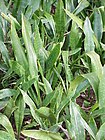Note: This is a project under development. The articles on this wiki are just being initiated and broadly incomplete. You can Help creating new pages.
Sansevieria hyacinthoides
Sansevieria hyacinthoides is a stemless evergreen perennial plant, producing succulent, erect, rigid leaves 15 - 85cm or more long and 25 - 80mm wide from a freely-spreading. The leaves can be up to 1.2 metres long. The flowering stem grows 45 - 75cm or more tall. The plant is gathered from the wild for the fibre obtained from its leaves. This is used locally. The plant is cultivated as a fibre crop in some parts of the tropics, especially tropical America, and is also often grown as an ornamental.
Contents
[hide]- 1 Uses
- 2 Parts Used
- 3 Chemical Composition
- 4 Common names
- 5 Properties
- 6 Habit
- 7 Identification
- 8 List of Ayurvedic medicine in which the herb is used
- 9 Where to get the saplings
- 10 Mode of Propagation
- 11 How to plant/cultivate
- 12 Commonly seen growing in areas
- 13 Photo Gallery
- 14 References
- 15 External Links
Uses
Internal parasites, Fevers, Toothache, Ear affections, Haemorrhoids.[1]
Parts Used
[[:Category:Herbs with used in medicine|]], stem, leaves, Root.
Chemical Composition
It contains phytochemical analyses revealed that the leaves, rhizomes, and roots are characterized by alkaloids, flavonoids, and steroids. Pharmacological research revealed that S. hyacinthoides crude extracts have anthelmintic, antibacterial, antifungal, and antioxidant activities.[2]
Common names
| Language | Common name |
|---|---|
| Kannada | |
| Hindi | |
| Malayalam | |
| Tamil | |
| Telugu | |
| Marathi | |
| Gujarathi | |
| Punjabi | |
| Kashmiri | |
| Sanskrit | |
| English |
Properties
Reference: Dravya - Substance, Rasa - Taste, Guna - Qualities, Veerya - Potency, Vipaka - Post-digesion effect, Karma - Pharmacological activity, Prabhava - Therepeutics.
Dravya
Rasa
Guna
Veerya
Vipaka
Karma
Prabhava
Habit
Identification
Leaf
| Kind | Shape | Feature |
|---|---|---|
Flower
| Type | Size | Color and composition | Stamen | More information |
|---|---|---|---|---|
| {{{5}}} |
Fruit
| Type | Size | Mass | Appearance | Seeds | More information |
|---|---|---|---|---|---|
Other features
List of Ayurvedic medicine in which the herb is used
Where to get the saplings
Mode of Propagation
Seeds, Division of the rootstock, Leaf cuttings.
How to plant/cultivate
A plant of the tropics. It grows best in areas where annual daytime temperatures are within the range 20 - 30°c, but can tolerate 15 - 36°c. It prefers a mean annual rainfall in the range 700 - 1,400mm, but tolerates 500 - 2,000mm.[4]
Commonly seen growing in areas
On bushveld, On savannah, On well drained sandy sol.
Photo Gallery
References
- Jump up ↑ Indian Medicinal Plants by C.P.Khare
- Jump up ↑ Chemical contituents
- Jump up ↑ [Morphology]
- Jump up ↑ Cultivation
External Links
- Ayurvedic Herbs known to be helpful to treat Internal parasites
- Ayurvedic Herbs known to be helpful to treat Fevers
- Ayurvedic Herbs known to be helpful to treat Toothache
- Ayurvedic Herbs known to be helpful to treat Ear affections
- Ayurvedic Herbs known to be helpful to treat Haemorrhoids
- Herbs with used in medicine
- Herbs with stem used in medicine
- Herbs with leaves used in medicine
- Herbs with Root used in medicine
- Habit - Evergreen perennial
- Index of Plants which can be propagated by Seeds
- Index of Plants which can be propagated by Division of the rootstock
- Index of Plants which can be propagated by Leaf cuttings
- Herbs that are commonly seen in the region of On bushveld
- Herbs that are commonly seen in the region of On savannah
- Herbs that are commonly seen in the region of On well drained sandy sol
- Herbs







